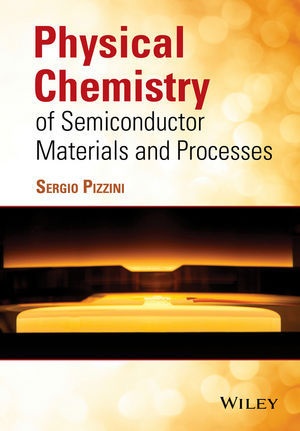Read more
The development of solid state devices began a little more than a century ago, with the discovery of the electrical conductivity of ionic solids. Today, solid state technologies form the background of the society in which we live.
The aim of this book is threefold: to present the background physical chemistry on which the technology of semiconductor devices is based; secondly, to describe specific issues such as the role of defects on the properties of solids, and the crucial influence of surface properties; and ultimately, to look at the physics and chemistry of semiconductor growth processes, both at the bulk and thin-film level, together with some issues relating to the properties of nano-devices.
Divided into five chapters, it covers:
* Thermodynamics of solids, including phases and their properties and structural order
* Point defects in semiconductors
* Extended defects in semiconductors and their interactions with point defects and impurities
* Growth of semiconductor materials
* Physical chemistry of semiconductor materials processing
With applications across all solid state technologies,the book is useful for advanced students and researchers in materials science, physics, chemistry, electrical and electronic engineering. It is also useful for those in the semiconductor industry.
List of contents
Preface ix
1. Thermodynamics of Homogeneous and Heterogeneous Semiconductor Systems 1
1.1 Introduction 1
1.2 Basic Principles 2
1.3 Phases and Their Properties 7
1.3.1 Structural Order of a Phase 7
1.4 Equations of State of Thermodynamic Systems 11
1.4.1 Thermodynamic Transformations and Functions of State 11
1.4.2 Work Associated with a Transformation, Entropy and Free Energy 12
1.4.3 Chemical Potentials 14
1.4.4 Free Energy and Entropy of Spontaneous Processes 15
1.4.5 Effect of Pressure on Phase Transformations, Polymorphs/Polytypes Formation and Their Thermodynamic Stability 16
1.4.6 Electrochemical Equilibria and Electrochemical Potentials of Charged Species 21
1.5 Equilibrium Conditions of Multicomponent Systems Which Do Not React Chemically 23
1.6 Thermodynamic Modelling of Binary Phase Diagrams 28
1.6.1 Introductory Remarks 28
1.6.2 Thermodynamic Modelling of Complete and Incomplete Miscibility 29
1.6.3 Thermodynamic Modelling of Intermediate Compound Formation 40
1.6.4 Retrograde Solubility, Retrograde Melting and Spinodal Decomposition 40
1.7 Solution Thermodynamics and Structural and Physical Properties of Selected Semiconductor Systems 43
1.7.1 Introductory Remarks 43
1.7.2 Au-Ag and Au-Cu Alloys 45
1.7.3 Silicon and Germanium 49
1.7.4 Silicon-Germanium Alloys 53
1.7.5 Silicon- and Germanium-Binary Alloys with Group III and Group IV Elements 55
1.7.6 Silicon-Tin and Germanium-Tin Alloys 61
1.7.7 Carbon and Its Polymorphs 62
1.7.8 Silicon Carbide 67
1.7.9 Selenium-Tellurium Alloys 69
1.7.10 Binary and Pseudo-binary Selenides and Tellurides 71
1.7.11 Arsenides, Phosphides and Nitrides 81
1.8 Size-Dependent Properties, Quantum Size Effects and Thermodynamics of Nanomaterials 93
APPENDIX 98
Use of Electrochemical Measurements for the Determination of the Thermodynamic Functions of Semiconductors 98
References 103
2. Point Defects in Semiconductors 117
2.1 Introduction 117
2.2 Point Defects in Ionic Solids: Modelling the Electrical Conductivity of Ionic Solids by Point Defects-Mediated Charge Transfer 119
2.3 Point Defects and Impurities in Elemental Semiconductors 127
2.3.1 Introduction 127
2.3.2 Vacancies and Self-Interstitials in Semiconductors with the Diamond Structure: an Attempt at a Critical Discussion of Their Thermodynamic and Transport Properties 129
2.3.3 Effect of Defect-Defect Interactions on Diffusivity: Trap-and-Pairing Limited Diffusion Processes 145
2.3.4 Light Impurities in Group IV Semiconductors: Hydrogen, Carbon, Nitrogen, Oxygen and Their Reactivity 153
2.4 Defects and Non-Stoichiometry in Compound Semiconductors 167
2.4.1 Structural and Thermodynamic Properties 167
2.4.2 Defect Identification in Compound Semiconductors 171
2.4.3 Non-Stoichiometry in Compound Semiconductors 171
References 181
3. Extended Defects in Semiconductors and Their Interactions with Point Defects and Impurities 195
3.1 Introduction 195
3.2 Dislocations in Semiconductors with the Diamond Structure 196
3.2.1 Geometrical Properties 196
3.2.2 Energy of Regular Straight Dislocations 201
3.2.3 Dislocation Motion 203
3.2.4 Dislocation Reconstruction 205
3.2.5 Electronic Structure of Dislocations in Si and Ge, Theoretical Studies and Experimental Evidences 208
3.3 Dislocations in Compound Semiconductors 215
About the author
SERGIO PIZZINIDepartment of Materials Science, University of Milano-Bicocca, Italy
Summary
The development of solid state devices began a little more than a century ago, with the discovery of the electrical conductivity of ionic solids. Today, solid state technologies form the background of the society in which we live.

